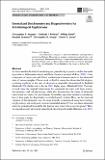| dc.contributor.author | Kempes, Christopher P. | |
| dc.contributor.author | Follows, Michael J | |
| dc.contributor.author | Smith, Hillary | |
| dc.contributor.author | Graham, Heather | |
| dc.contributor.author | House, Christopher H. | |
| dc.contributor.author | Levin, Simon A. | |
| dc.date.accessioned | 2022-07-06T19:03:53Z | |
| dc.date.available | 2021-11-01T14:33:25Z | |
| dc.date.available | 2022-07-06T19:03:53Z | |
| dc.date.issued | 2021-05-18 | |
| dc.identifier.uri | https://hdl.handle.net/1721.1/136792.2 | |
| dc.description.abstract | Abstract
A central need in the field of astrobiology is generalized perspectives on life that make it possible to differentiate abiotic and biotic chemical systems McKay (2008). A key component of many past and future astrobiological measurements is the elemental ratio of various samples. Classic work on Earth’s oceans has shown that life displays a striking regularity in the ratio of elements as originally characterized by Redfield (Redfield 1958; Geider and La Roche 2002; Eighty years of Redfield 2014). The body of work since the original observations has connected this ratio with basic ecological dynamics and cell physiology, while also documenting the range of elemental ratios found in a variety of environments. Several key questions remain in considering how to best apply this knowledge to astrobiological contexts: How can the observed variation of the elemental ratios be more formally systematized using basic biological physiology and ecological or environmental dynamics? How can these elemental ratios be generalized beyond the life that we have observed on our own planet? Here, we expand recently developed generalized physiological models (Kempes et al. 2012, 2016, 2017, 2019) to create a simple framework for predicting the variation of elemental ratios found in various environments. We then discuss further generalizing the physiology for astrobiological applications. Much of our theoretical treatment is designed for in situ measurements applicable to future planetary missions. We imagine scenarios where three measurements can be made—particle/cell sizes, particle/cell stoichiometry, and fluid or environmental stoichiometry—and develop our theory in connection with these often deployed measurements. | en_US |
| dc.publisher | Springer US | en_US |
| dc.relation.isversionof | https://doi.org/10.1007/s11538-021-00877-5 | en_US |
| dc.rights | Creative Commons Attribution | en_US |
| dc.rights.uri | https://creativecommons.org/licenses/by/4.0/ | en_US |
| dc.source | Springer US | en_US |
| dc.title | Generalized Stoichiometry and Biogeochemistry for Astrobiological Applications | en_US |
| dc.type | Article | en_US |
| dc.identifier.citation | Bulletin of Mathematical Biology. 2021 May 18;83(7):73 | en_US |
| dc.contributor.department | Massachusetts Institute of Technology. Department of Earth, Atmospheric, and Planetary Sciences | en_US |
| dc.identifier.mitlicense | PUBLISHER_CC | |
| dc.eprint.version | Final published version | en_US |
| dc.type.uri | http://purl.org/eprint/type/JournalArticle | en_US |
| eprint.status | http://purl.org/eprint/status/PeerReviewed | en_US |
| dc.date.updated | 2021-05-23T03:15:48Z | |
| dc.language.rfc3066 | en | |
| dc.rights.holder | The Author(s) | |
| dspace.embargo.terms | N | |
| dspace.date.submission | 2021-05-23T03:15:48Z | |
| mit.license | PUBLISHER_CC | |
| mit.metadata.status | Publication Information Needed | en_US |
